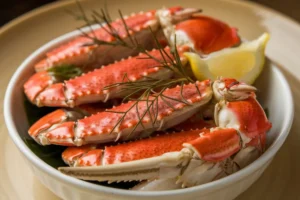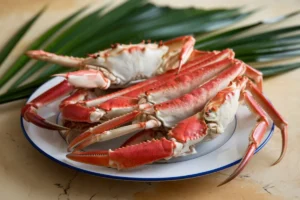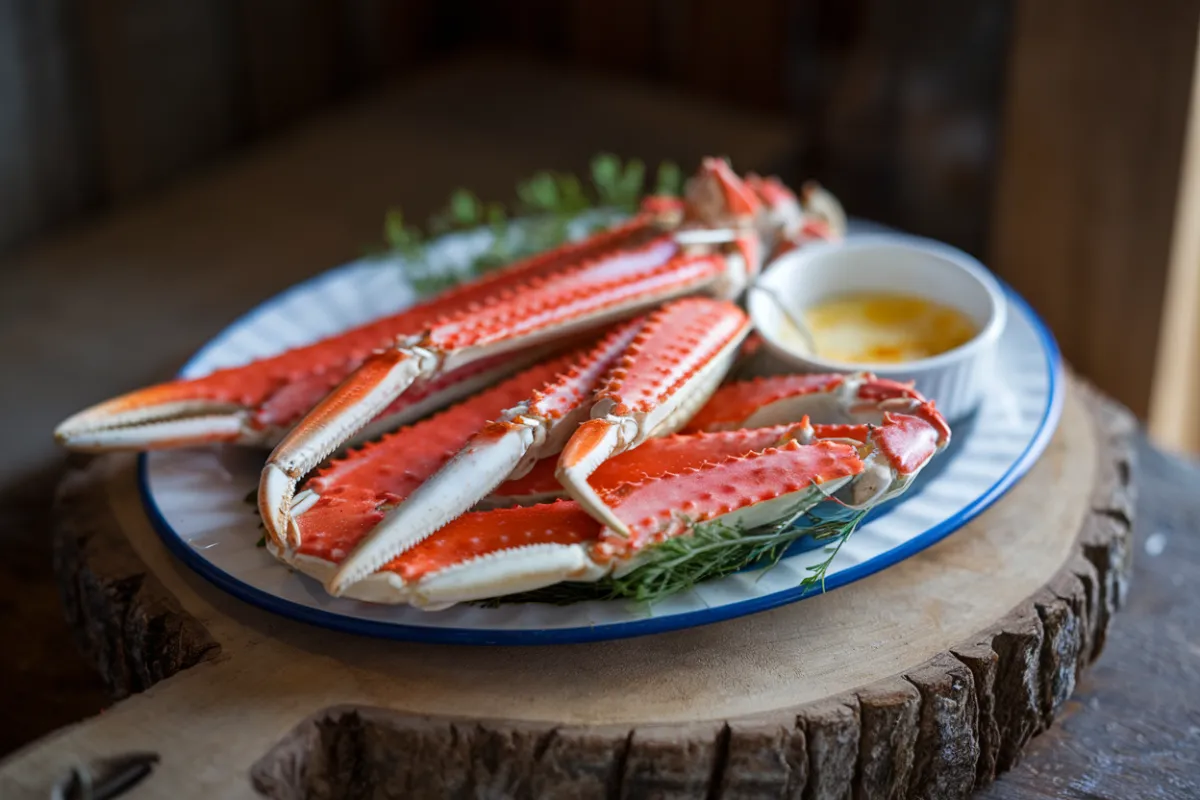Snow crab legs are a popular seafood delicacy, known for their tender meat and mild, sweet flavor. Whether you’re a seasoned seafood chef or a beginner in the kitchen, snow crab legs are an excellent choice for a simple yet impressive meal. In this guide, you’ll discover everything you need to know about buying, cooking, and enjoying snow crab legs.
What Are Snow Crab Legs?
Snow crab legs come from the snow crab, a species found in the cold waters of the North Atlantic and North Pacific oceans. These crabs have long, slender legs filled with delicate, flavorful meat. The mild taste of snow crab legs pairs well with a variety of seasonings and sauces.
Unlike the larger king crab, snow crabs offer a subtler flavor and a firm, shreddable texture. This makes them a favorite for those who prefer a less intense seafood experience. Additionally, snow crabs are more abundant and less expensive than king crabs, making them more accessible to a wider audience.
To learn more about the differences between snow crabs and king crabs, check out this guide on where to buy quality snow crab legs and tips for cooking them. Furthermore, this resource offers valuable information on selecting and preparing snow crab legs to ensure the best results.
Nutritional Benefits of Snow Crab Legs
Snow crab legs are not only delicious but also packed with essential nutrients. Here are some key benefits:
- High in Protein: Snow crab legs provide a good source of lean protein, which is essential for muscle building and repair.
- Low in Fat: With very little fat, snow crab legs are an excellent option for those monitoring their fat intake.
- Rich in Vitamins and Minerals: Snow crab legs contain vitamins B12 and C, along with minerals like zinc, copper, and selenium.
These qualities make snow crab legs a nutritious choice, allowing you to enjoy a healthy meal without compromising on flavor.
Buying Snow Crab Legs
When buying snow crab legs, consider these tips to ensure you get the best product:
- Fresh vs. Frozen: Snow crab legs are usually pre-cooked and frozen. Fresh snow crab legs are rare, so frozen legs are often the best choice. Look for firm legs with a bright, glossy shell.
- Check for Damage: It’s important to avoid legs with any signs of damage, such as cracks or discoloration.
- Size Matters: While larger legs may seem more appealing, smaller legs are often more tender and easier to cook evenly.
For the best selection, consider purchasing snow crab legs from reputable seafood markets or online retailers.
Snow Crab vs. King Crab: A Comparative Analysis

When deciding between snow crab legs and king crab legs, it’s important to consider the differences:
- Size: King crabs are significantly larger, with thicker, meatier legs. However, snow crab legs have thinner shells, making the meat easier to extract.
- Flavor: Snow crabs have a delicate, slightly sweet flavor that works well with various seasonings. On the other hand, king crabs offer a richer, more succulent taste.
- Texture: The meat from snow crab legs is firm yet tender, with a texture that shreds easily. King crab meat, in contrast, is more robust and requires more effort to extract.
Overall, snow crab legs are an excellent choice for those who prefer a more subtle flavor and delicate texture. They are also more affordable and easier to prepare, making them a great option for home cooks.
How to Cook Snow Crab Legs
There are several methods for cooking snow crab legs, each of which brings out the unique flavors and textures of the crab meat. Below, we explore the most popular methods: boiling, steaming, baking, and grilling.
Boiling Snow Crab Legs
Boiling is one of the simplest and most common methods for cooking snow crab legs. It’s quick and easy, but it’s important to avoid overcooking the legs, as this can lead to waterlogged meat.
- Prepare the Pot: Fill a large pot with water and add a tablespoon of coarse kosher salt. Bring the water to a rolling boil.
- Add the Crab Legs: Carefully add the snow crab legs to the boiling water. If the legs are thawed, boil for 3 minutes; if frozen, boil for 5 minutes.
- Drain and Serve: Once cooked, remove the legs from the pot and drain them on a paper towel-lined baking sheet. Serve immediately with your choice of dipping sauce.
Boiling is a great method for those who prefer their snow crab legs to be tender and moist, with a subtle, briny flavor that highlights the natural sweetness of the crab meat.
Steaming Snow Crab Legs
Steaming is another excellent method for cooking snow crab legs. It helps to retain more of the crab’s natural flavor and moisture, which is crucial for a rich dining experience.
- Prepare the Steamer: Place a steamer basket in a large pot with water just below the basket. Add a couple of teaspoons of kosher salt and bring the water to a simmer.
- Steam the Legs: Place the snow crab legs in the steamer basket, ensuring they are not overcrowded. Cover the pot and steam the legs for 5 minutes if thawed, or 7 minutes if frozen.
- Serve Hot: Remove the legs from the steamer and serve immediately with melted butter or your favorite sauce.
Steaming is ideal for those who want to preserve the natural juices within the legs and enhance the overall taste.
Baking Snow Crab Legs
Baking snow crab legs is a simple and effective way to cook the legs without needing special equipment. This method allows the crab meat to steam within its shell, preserving moisture and flavor.
- Preheat the Oven: Preheat your oven to 350°F.
- Prepare the Crab Legs: Place the snow crab legs on a rimmed baking sheet or in a high-sided casserole dish. Cover the legs tightly with aluminum foil to trap the steam.
- Bake: Place the baking sheet or casserole dish in the oven and bake for 10-12 minutes for thawed legs. If the legs are frozen, bake for 12-15 minutes.
- Serve Immediately: Remove the legs from the oven, carefully peel back the foil, and serve hot with your favorite dipping sauce.
Baking is a great option for those who want to avoid the risk of waterlogging the crab meat while still retaining its delicate flavor and texture.
Grilling Snow Crab Legs
Grilling adds a smoky flavor to snow crab legs that is hard to beat. However, it’s important to watch the legs closely to avoid drying them out during the cooking process.
- Heat the Grill: Preheat your grill to medium heat.
- Prepare the Legs: Lightly oil the grill grates to prevent sticking. Then, place the snow crab legs directly on the grill.
- Grill Time: Grill the legs for 3-4 minutes, just until heated through.
- Serve Hot: Remove the legs from the grill and serve immediately with your choice of dipping sauce.
Grilling is an excellent method for those who enjoy a smoky flavor and a slightly crisp texture in their snow crab legs.
Enhancing the Flavor of Snow Crab Legs

While snow crab legs are delicious on their own, they can be enhanced with a few well-chosen seasonings and sauces. This allows you to create a truly memorable meal.
Recommended Seasonings
- Old Bay: A classic seafood seasoning that adds a zesty, slightly spicy kick to snow crab legs.
- Fennel Seeds: These seeds add a subtle, sweet anise flavor that complements the delicate taste of the crab meat.
- Blackened Seasoning: For those who like a bit of heat, blackened seasoning adds a bold, spicy flavor that pairs well with the natural sweetness of snow crab legs.
Popular Dipping Sauces
- Clarified Butter: The go-to choice for dipping crab legs, clarified butter adds a rich, creamy flavor that enhances the sweetness of the crab meat.
- Garlic Butter Sauce: A flavorful variation on clarified butter, garlic butter sauce adds an extra layer of richness and depth to the dish.
- Cocktail Sauce: For a tangy, slightly spicy contrast to the sweet crab meat, cocktail sauce is a popular choice.
These seasonings and sauces can be mixed and matched to create a unique flavor profile that suits your taste.
Serving Suggestions and Side Dishes
Snow crab legs pair wonderfully with a variety of side dishes, making them a versatile centerpiece for any meal. Here are some serving suggestions that complement the delicate flavor of snow crab legs:
- Roasted Potatoes: The crispy, golden exterior and fluffy interior of roasted potatoes offer a satisfying contrast to the tender meat of the crab. Season the potatoes with herbs like rosemary and thyme to enhance their flavor.
- Corn on the Cob: Sweet and buttery corn on the cob is a classic side dish that pairs perfectly with snow crab legs. You can also try Mexican street corn for a tangy and spicy twist.
- Garlic Bread: Warm, buttery garlic bread or cheesy garlic knots provide a rich, savory accompaniment that complements the mild sweetness of the crab meat.
- Coleslaw: A refreshing, crunchy coleslaw adds a touch of acidity that balances the richness of the snow crab legs. Opt for a classic vinegar-based coleslaw or a creamy version, depending on your preference.
- Grilled Vegetables: Lightly charred grilled vegetables like asparagus, zucchini, and bell peppers bring a smoky, earthy flavor that pairs well with the delicate crab meat.
- Salads: Simple salads like a fresh garden salad or a Caesar salad add a crisp, green element to your meal, offering a refreshing contrast to the richness of the crab legs.
These sides not only enhance the flavor of snow crab legs but also add variety and balance to your meal.
How to Crack and Eat Snow Crab Legs
Cracking open snow crab legs is an easy and satisfying process that requires minimal tools. Here’s how to do it:
- Break at the Joint: Start by snapping the crab legs apart at the joint where they connect. This will expose the meat and make it easier to access.
- Wiggle and Pull: Gently wiggle the leg halves back and forth until the shell cracks. Once it does, pull the halves apart to reveal the meat inside.
- Use a Lobster Fork: For tougher sections, such as the knuckle and claw, use a lobster fork or a small seafood fork to extract the meat. This tool is especially useful for reaching into narrow sections of the leg where the meat can be tricky to access.
- Enjoy the Meat: Once the meat is extracted, dip it into your favorite sauce and enjoy the sweet, tender flavor of the snow crab.
Even if you’re new to eating snow crab legs, this process is easy to master with a bit of practice.
Storage and Freezing Tips
If you have leftover snow crab legs or want to store some for later, proper storage is key to maintaining their freshness and flavor. Here are some tips for storing and freezing snow crab legs:
- Refrigeration: If you plan to eat the crab legs within a day or two, store them in the refrigerator. Place the cooked crab legs in an airtight container or wrap them tightly in plastic wrap. They can be stored in the fridge for up to 2 days.
- Freezing: For longer storage, freezing is the best option. Allow the cooked crab legs to cool to room temperature before wrapping each leg individually in plastic wrap. Then, place the wrapped legs in a heavy-duty freezer bag or an airtight container to prevent freezer burn. Snow crab legs can be frozen for up to 3 months without losing their quality.
- Thawing: When you’re ready to enjoy your frozen snow crab legs, thaw them in the refrigerator overnight. For a quicker thaw, you can place the frozen legs in a bowl of cold water for a few hours.
Proper storage and freezing techniques ensure that your snow crab legs remain fresh and delicious, even if you’re saving them for later.
FAQs About Snow Crab Legs

How Many Snow Crab Legs Are in 1 lb?
Typically, you’ll find about three snow crab leg clusters in 1 pound. Each cluster consists of several legs connected to a portion of the crab’s body, providing a substantial amount of meat.
How Many Will 10 lbs of Snow Crab Legs Feed?
Generally, 10 pounds of snow crab legs will feed approximately 7-8 people, depending on the portion sizes and what other dishes are being served. If snow crab legs are the main course, plan on about 1.5 to 2 pounds per person.
Are Snow Crabs Healthy?
Yes, snow crabs are a healthy seafood option. They are low in fat and calories while being high in protein. Additionally, snow crab legs are rich in essential vitamins and minerals, including vitamin B12, selenium, and zinc, which support overall health.
What’s the Best Way to Cook Snow Crab Legs?
While all methods have their merits, steaming is often recommended for its ability to preserve the crab’s natural moisture and flavor. However, boiling, baking, and grilling are also excellent options, depending on your preference and the equipment you have available.
Conclusion
Snow crab legs are a versatile and delicious seafood option that can be prepared in a variety of ways to suit any taste. Whether you’re boiling, steaming, baking, or grilling, snow crab legs are easy to cook and provide a satisfying, nutrient-rich meal. By following the tips and techniques outlined in this guide, you can confidently prepare and enjoy snow crab legs at home, impressing your family and friends with a restaurant-quality seafood experience.

